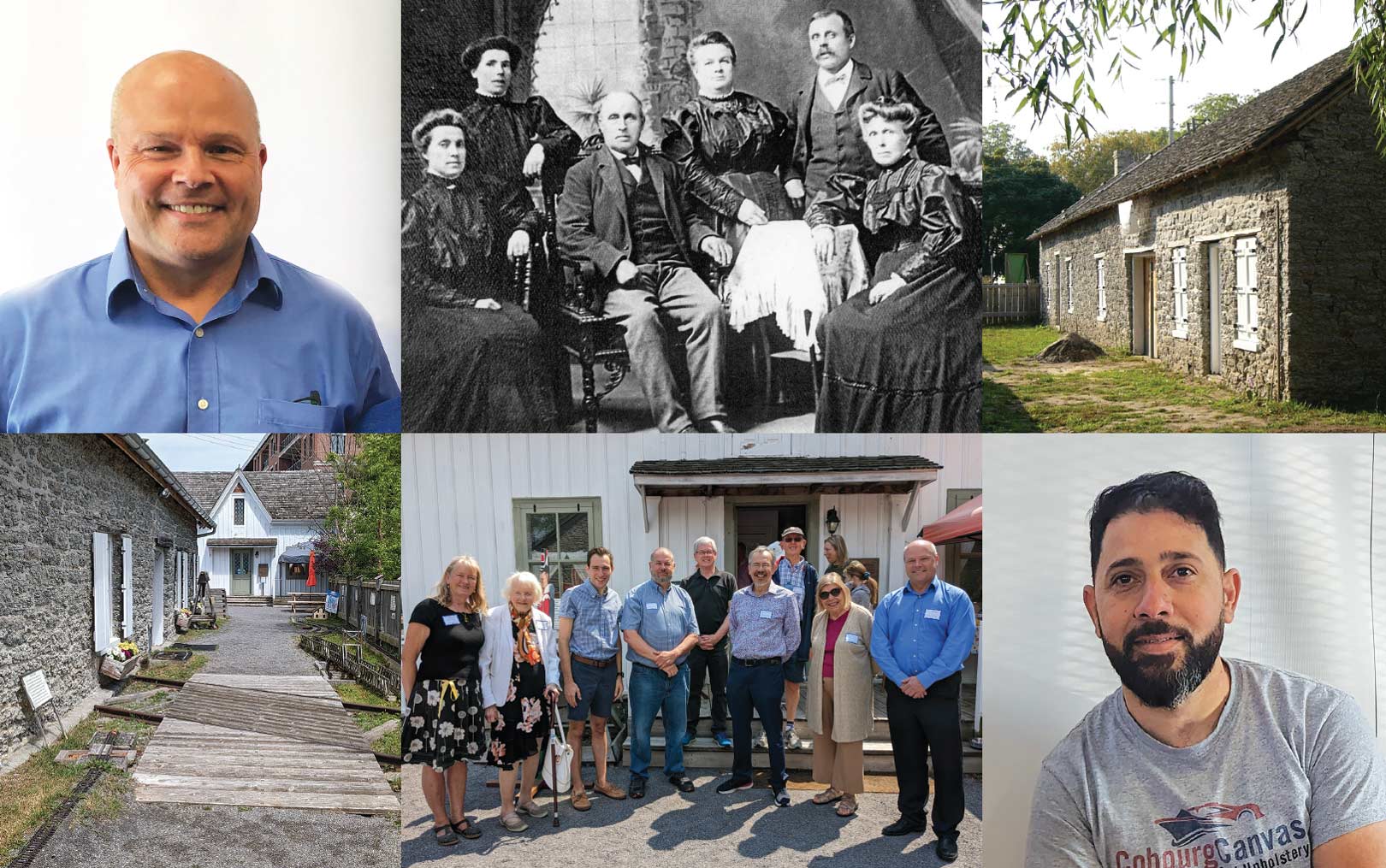
Clockwise from left: Dan Bulger; Dan Bulger’s family; the Cobourg Museum: Mohammad Wahbi; storytellers of last June at the Cobourg Museum; Cobourg Museum. Photographs courtesy the Cobourg Museum Foundation
Home is about belonging and connecting to your community. As immigration is changing the local demographic, the Cobourg & Area Museum marks a quarter-century of stories about identity, discovery and finding home.
If you live in the Cobourg area, you might know Dan Bulger – or the Irish family name. He was born and raised here, rode his bike around town with his friends and played at the beach as a kid. After going away to college, he decided Cobourg was the place to stay. He joined his dad, Joseph Bulger, in the real estate business as a broker, became a Rotarian and has volunteered at the local YMCA for decades. “Cobourg is a wonderful place to live,” he says. “I have the opportunity as an adult to make sure Cobourg continues to thrive.”
Dan has always appreciated having so many relatives living close by, including elderly great aunts of his who were well-known boisterous hockey fans, and his Great Aunt Julia who everyone called the Mayor of Forth Street. When he was invited to share stories about his Cobourg roots for a video project about immigration, he saw it as a way to pay homage to the close-knit family ties.
The Cobourg Museum Foundation’s Our Stories, Our Community 10-part video series features storytellers who are newcomers to the area themselves, or like Dan’s ancestors, who chose Northumberland County as home, all overcoming huge challenges and leaving the familiar behind to start over. The series will be shown this season as the Foundation marks its 25th anniversary, celebrating the work of a dedicated group who rallied countless community volunteers.
How did the Bulgers come to Cobourg? James Bulger, a poor tenant farmer in County Wicklow, died in the mid-1840s during the Great Irish Famine when Ireland experienced back-to-back harvest failures caused by the potato blight. His widow, Julia Kealy Bulger, and the couple’s 11 children were among the two million people who left their homeland. The family came by ship to Canada, a voyage of more than 30 days at sea in cramped quarters rife with sickness. They were destined for Toronto but hit ice and landed in Cobourg – where they decided to stay. At that time, in 1849, Cobourg had grown to 5,000 citizens with a waterfront that served the thriving shipping industry. Cobourg residents were benevolent and generous, taking immigrants in and giving them food and care, historian Rob Mikel told Northumberland News in 2005 in a story about the waterfront history. Local citizens sent ₤300 in financial relief to Ireland in 1847, he noted.
History doesn’t just happen with one big thing – it’s the individual stories like these of people, places and events through time.
The welcoming of immigrants is woven throughout Cobourg’s story as people have come here from different places and under different circumstances. One of the most immediate examples is people coming from Syria because of the devastation of the civil war there.
Mohammad Wahbi, another storyteller featured in the compelling video series, talks about bringing his wife and children to Cobourg from Syria in December 2015. In the video, he talks about businesses and houses burned to the ground, including the upholstery shop for cars and vans that he’d opened after learning the trade for six years. “There were car seats, foam, materials, tools, everything was gone,” he says. He got a call from a sponsor in Canada who brought a translator to meet the family when they arrived in Canada, translating English to Arabic. “On that first morning, we woke up and looked out the window. It was snowing.”
Mohammad studied English and then got a job at Cobourg Canvas and Upholstery. Six months later, the store owner retired and Mohammad worked to eventually buy the business himself. “We like this area so much. It’s a good community and we have a lot of friends.”
Another video in the series also illustrates the displacement that happens with war. Martha Habermehl and her daughter Joanna Weirsma tell stories of Germany invading the Netherlands during Second World War. The family left their home in Holland by ship in 1959, first coming to Newmarket and later to Cobourg, where they were active in the community and helped erect a memorial in Victoria Park to remember victims of violence.
As for the 11 Bulger children of James and Julia, many stayed in the area and there were 58 grandchildren, of whom seven were named Julia. The family matriarch was highly regarded.
“Immigration really is the Canadian story,” Dan says, recognizing the struggles his ancestors faced in their early lives in Ireland and then coming to Cobourg. “I’m proud that this is my home and where I’ve raised my family.”
History doesn’t just happen with one big thing – it’s the individual stories like these of people, places and events through time. For the Cobourg Museum Foundation, sharing the legacy of the area started with saving a heritage building from demolition and creating a space to tell stories that connect visitors and residents to the community.
“The past gives us lessons we should not forget. We can learn from it, and we should keep it alive or we won’t know where we came from.” MARY DUNPHY
“There was a good consensus that we needed to be more vocal about the early years of the settlement of the area and try to create something where the local people could help build knowledge of the inheritance that we have in the community as well as be attractive to tourists,” says former Cobourg Mayor Joan Chalovich, co-founder of the museum, which was named the Sifton-Cook Heritage Centre at 141 Orr St. in downtown Cobourg just three blocks west of the iconic Victoria Hall. She worked with a small “eclectic group of people” of local historians like the late Doug Sifton, home builders, history teachers and retired military, including Dave Cook. They purchased the historic limestone building, which was crumbling on the site. The long, narrow building, thought to have been a barracks for soldiers during the War of 1812, was used in the 1830s in the successful distillery and brewery business of entrepreneur James Calcutt who arrived from Ireland in 1832.
After much work to restore the building and networking with other local organizations for support, the non-profit Foundation bought an additional piece of land adjacent to the site. An 1870s workman’s cottage was donated and moved on to the land from a nearby estate. The cottage was rebuilt to modern standards to serve as a visitor’s centre and admin building, allowing the limestone museum’s exhibit hall to feature more artifacts and to create a learning space for presentations.
The hall has showcased annual themed exhibits over the years, like a timeline of triumphs and adversity, including Cobourg at incorporation in 1837, very influential (Cobourg was a contender to become the capital of Ontario), architecture, industry, sports (Justin Williams played 19 seasons in his NHL career, winning the Stanley Cup three times) and transportation developments from steamers and stagecoaches to rail travel. The Cobourg and Peterborough Railway opened in 1854, crossing a massive but ill-fated bridge that extended almost 5km across Rice Lake. There’s a 1:20 scale presentation of the railway that runs on an outdoor track on the museum property, always to the delight of kids and locomotive fans.
Now in her 80s, Joan Chalovich is still very active on the Foundation board. She’s seen interest in the museum grow as the community has evolved over 25 years with the Rotary Club’s expansion of the Cobourg Waterfront Festival (which brings thousands of visitors to the area for the Canada Day weekend celebrations) and the development of the Cobourg Marina as a key tourist draw – just two examples of the many things to love about the area. “We’ve always said, ‘on a rainy day, come over and see what we’ve got,’” Joan says of special events held at the centre over the peak summer season. The centre is open to the public from Victoria Day weekend to the Canadian Thanksgiving holiday. Admission is free, donations are welcome, and the rally cry for volunteers who run the museum and share stories with people who stop by is always loud and clear.
As demographics in Canada have changed in the last 20 years, along with the recent trend of people leaving cities for country living spurred by the pandemic, the Northumberland area is known as ideal for people who want to have a rural lifestyle and still connect with the city. As Joan sees it, “It’s important to have a place for everybody in the mix. The current board’s outreach has been so well put together and received by the broader community.” This year also marks the renaming of the centre as the Cobourg & Area Museum to help everyone easily identify the facility as a museum experience.
The current season opened May 18 with the unfurling of the flag, speeches and honoured guests, including Joan who was presented with a special volunteer award. Coming up is the Ganaraska Chordsmen Barbershop Chorus on July 13 at noon, the 25th anniversary tea party on July 20 from 2 to 3:30 p.m., and the second annual Newcomers’ Day on August 24 to welcome new residents.
“The past gives us lessons we should not forget. We can learn from it, and we should keep it alive or we won’t know where we came from,” says Mary Dunphy, the Foundation president, who moved to Cobourg from Toronto in 2015 to escape the traffic and congestion. She first joined as a volunteer guide meeting visitors to the museum on Saturday afternoons. “Cobourg has a rich history for such a small town,” she says, adding the research and work for the annual themes on exhibit has been impressive. The Foundation is now working to bring all the stories of these themes into one permanent Cobourg history exhibit for 2025.
Sharing stories of past and present helps build that common thread of identity and community as we grow and change. “Culturally we’re changing, as we’re seeing different cultures move into the area,” Mary says. “That’s good. There’s a new identity happening.”
Story by:
Karen Hawthorne




